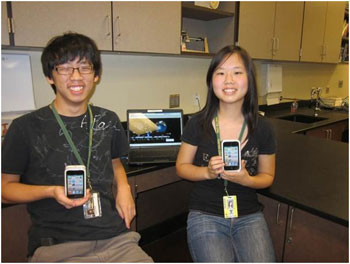Students tackle Lab's climate simulation challenge
 (Download Image)
Seokho Hong and his sister Inyoung Hong were the first and second place winners, respectively, of the Tracy High School contest based on the Lab's climate simulation tool. Unlike most contests where high scores are sought, the object of the climate simulation challenge is to acquire the lowest score -- in regard to energy use.
(Download Image)
Seokho Hong and his sister Inyoung Hong were the first and second place winners, respectively, of the Tracy High School contest based on the Lab's climate simulation tool. Unlike most contests where high scores are sought, the object of the climate simulation challenge is to acquire the lowest score -- in regard to energy use.
How are climate change and energy demands linked? What energy options are available to our nation and the world?
These are only a few of the questions Tracy High School students explored during a recent school contest based on LLNL's climate simulation learning tool found on the Climate Simulation Website.
"The goal is to have students gain a better understanding of how climate change and mankind's energy demands are connected," said Tracy High science teacher Dean Reese.
Reese participated in the Lab Science Education Program's Teacher Research Academy and in the DOE-funded Academies Creating Teacher Scientists program. He came up with the idea of using the climate contest as a follow-up to his classroom project that analyzed the CO2 trapped in mustard plant leaves found near Tracy. The project was funded through a gift from Lawrence Livermore National Security, LLC.
The Lab's climate simulation invited all interested Tracy High School students to meet 21st century energy needs while keeping carbon emissions to a minimum. The simulation was first introduced at the USA Science Engineering Festival Expo on the National Mall in Washington last October and continues to be featured at local science fairs, as well as on the Web. It has been popular with students, teachers and the general public alike.
Believed to be the first such climate learning tool to use actual energy data and statistics compiled by scientists, the simulation was a collaborative effort of several LLNL researchers and programmers as part of the Lab's ongoing science education outreach.
Reese, along with fellow science teacher Ken Wedel, provided a lecture beforehand to explain the concepts of climate change, energy demand and types of available energy. Students' attendance at the lectures made them eligible to enter the contest conducted during the lunch hour.
Contact
Linda A Lucchetti[email protected]
925-422-5815
Tags
Physical and Life SciencesFeatured Articles







